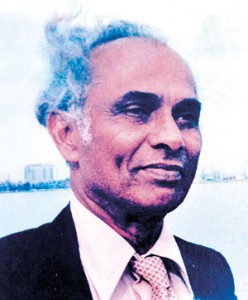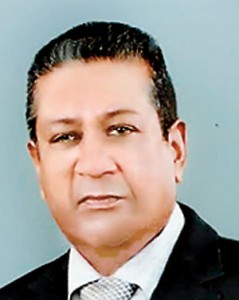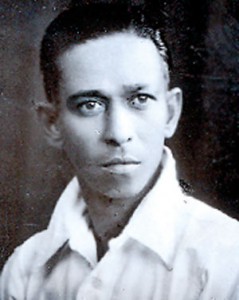Appreciations
View(s):Dr. JUSTIN SAMARASEKERA
 Remembering an illustrious architect
Remembering an illustrious architect
May 21, 2016, marked the hundredth birth anniversary of an illustrious personage – the architect Dr. Justin Samarasekera. His demise in 2003 left a void in the architectural profession. He is remembered not only for his forthright manner, his success based on ethical conduct, his knowledge and sagacity, but also for his open-hearted warmth.
I knew him for the better part of my life. I value the opportunity I had of joining his office as the first of many qualified architects that followed. My stay there was short but in later years we collaborated on many matters. This article briefly sketches the career of this multi-faceted personality. It is presented so that those who knew him can refresh their memories and also to benefit those who did not have the good fortune to have known him personally.
Justin was born in a coastal village in the deep South near Dondra. His father was a respected English school teacher. His secondary education was gained in Colombo at Ananda and also at Nalanda. Later, he chose to study architecture for which there were no facilities available locally. The best known facility nearby was the Sir J.J.School of Architecture in Bombay where he enrolled in 1938. The school’s five-year programme of studies had partial recognition from the Royal Institute of British Architects (RIBA). At that time India was in the throes of the nationalist struggle for independence from British rule. Most Indian students were active participants in this struggle. Justin too participated and was strongly influenced by this movement which left an indelible imprint on his personality.
On his return from Bombay after graduating in 1943, Justin joined the Public Works Department (PWD) – the only government institution that employed architects in those days. He travelled to London in 1946 at his own cost to sit the RIBA’s special final examination which he passed. He returned home and to the PWD. He rose there to the position of Chief Architect and left in 1962 to start his own practice under the name Justin Samarasekera Associates. It became a successful practice which flourished for several decades.
He was the architect of many prominent projects. These included the headquarters of the Sri Lanka Insurance Corporation and also of the Sri Lanka Freedom Party among many other projects. He provided the concept design for the Kalutara Bodhi Stupa. His office also became a training ground for many students and young architects some of whom have themselves moved on to become successful architects in their own right.
Early in his career following his Indian experience, he took a keen interest in some of the intellectual and cultural activities that were available to him locally. He was a founding member of the Sri Lanka Association for the Advancement of Science (SLAAS) when it was established in 1946. In 1976 he was elected their general president. It was and still is the largest independent scientific body in the country. He designed the building that is owned and occupied by SLAAS. Later he also became a Founding Fellow of our National Academy of Sciences when it was formed, which is arguably the most prestigious independent scientific body in Sri Lanka. In 1985 he became its president.
The Ceylon Institute of Architects was established in 1957. Justin was among the few pioneer architects in this effort. One of the main activities of the new Institute was to make arrangements for establishing facilities for architectural education in the country. This effort went through many stages. There was first a three year course of full-time study made available in 1961 at the Institute of Practical Technology in Katubedda. The course started with just 15 students. Justin was closely involved in this effort while working from his own private office which was then located in Colombo Fort at Chatham Street. He was one of the key personalities who helped the fledgling school of architecture to move to a building in Ward Place in Colombo as a part of the Faculty of Science within the Colombo Campus of the University of Ceylon. This not only gave the school more prestige but also helped in utilizing the expertise of architects based in Colombo as visiting lecturers.
Justin himself acknowledges in his memoirs the considerable support he had in this endeavour from the Education Ministry, the Minister and particularly its then Permanent Secretary. A few years later he was notably among those who encouraged moving the school back to Moratuwa – but this time as an integral part of the university campus there and to eventually gain the status of an independent faculty.
He was indefatigable in his efforts to develop architectural education. He strongly favoured close contact with the Royal Institute of British Architects (RIBA). His personal contact with the prominent British Architect/Planner Lord Richard Llewelyn-Davies was crucial. He was Professor of Architecture at the Bartlett School, University College London and later Professor of Urban Planning and head of the School of Environmental Studies at the University of London. This contact eventually resulted in a ‘twinning’ arrangement between the school at Moratuwa and the Bartlett School. Recognizing Justin’s valuable contribution, the University of Moratuwa awarded him an honorary doctorate.
Justin had lived for the better part of his adult life with his wife in a house he had built in Model Farm Road near the Royal Colombo Golf Club. They had raised their three children there. The death of his wife in 1991 after 43 years of marriage left Justin a very lonely man. He remarried and soon engrossed himself with building a small block of flats on a piece of land which he had bought in Isipathana Mawatha. He eventually moved into the penthouse apartment in 1996 but not before the demise of his second wife. While he continued his architectural practice on a reduced scale, he began to focus his attention on reading, drawing and painting. Most of this artistic work was inspired by the natural surroundings he found in our national parks, forests and sanctuaries. His output was prolific which led to three successful exhibitions the first of which was declared open by Mrs. Sirimavo Bandaranaike in 1997. By then Justin was diagnosed as having Parkinson’s disease which had begun to take hold of him and restrict his physical movements. He could no longer swim, an activity which he enjoyed. He passed away peacefully at the age of 87.
- Dr. Locana Gunaratna
YOHAN DEVANANDA
We will miss this gifted and many-faceted human being
Yohan Devananda’s entry into a fuller life recently has brought to an end a distinctive period in the life of the Church and nation in Sri Lanka. In his life, the action and contemplation of the founder of the Devasaranaramaya; the beauty of a liturgist par excellence and a caring people-oriented priest; an advocate for the poor farmers and a passionate activist for justice and human rights for all oppressed people were fused into a single personality.
Although we shall miss this many-faceted and gifted human being, many of us will treasure his memory and be inspired forever as he had a profound impact on our lives. His vision as embodied in his writings and simple lifestyle and in the lives of present day ‘sevakas’ and peacemakers will undoubtedly live on.
Under the tutelage of the first Bishop of Kurunegala, the Most Rev. Lakdasa de Mel, the Rev. Yohan Devananda began living the religious community life in 1957 at Hevadiwela and later in the ‘Devasaranaramaya’ in 1960 at Ibbagamuwa near Kurunegala. This ashram drew its inspiration from the Christian monastic tradition as well as the ‘ashrama’and ‘aramaya’ traditions of Hinduism and Buddhism. Till 1984 Yohan served as “Prathama Sevaka” and exercised a remarkable influence on the life and witness of the Church both locally and abroad and the Diocese of Kurunegala in particular; in the spheres of indigenisation and dialogue with the Buddhist Sangha and involvement with the issues of the peasantry, workers, students and rural youth.
He made a great impact on the youth in the Church of Ceylon Youth Movement (CCYM) and students of the Student Christian Movement of Sri Lanka (SCM). Christians from the villages in the Diocese of Kurunegala, social activists, intellectuals and secular humanists were attracted to the Devansaranaramaya and supported it through a meals calendar and in other ways.
In the wake of the first youth revolt led by the Janatha Vimukthi Peramuna (JVP), Yohan began the collective farm at the request of unemployed youth and with the support of Bishop Lakshman Wickremesinghe. Yohan thereafter got more deeply involved in the issues of the peasantry and was active in reviving the All Lanka Peasants Congress. He was instrumental in encouraging the formation of the Progressive Women’s Front and the Vimukti Dharma Kendra.
Yohan was a strong supporter of the Christian Workers Fellowship (CWF) and played a creative role in the crafting of the May Day workers mass. Since 1960 at its inception, he was unfailingly present at the May Day mass to lead in the chanting of the ‘great thanksgiving’ with bishops, clergy and laypersons from all the churches. We shall now miss his glorious voice and passionate liturgical presence! There was creative liturgical interaction between the CWF and Devasarana for a long period. The new world liturgy in the context of inter faith worship inspired the CWF’s fellowship meal.
With the intensifying racial conflict between the Sinhala majority and the Tamil minority, Yohan became a peace activist and worked tirelessly to build bridges of understanding between these two communities. The World Solidarity Forum (WSF) for Justice and Peace (established 1990), founded by him and other like minded peace makers in Sri Lanka and abroad was one of several NGOs presenting an alternative vision and a space for dialogue and action towards ensuring human rights for all Sri Lankans, within a repressive political context. He consulted widely with religious leaders and challenged successive governments to move in the direction of a just political solution. The booklet ‘War or Peace’ and many open letters to the political leadership since the 1980s bear witness to Yohan’s passion for peace drawing on the resources of the four living faiths.
He was well supported in this journey by his wife (since 1985) the Rev. Canon Malini Devananda; whose gifts in her ministry of Christian education, in mobilising women, engaging in wider ecumenism, theological formation and in her writings supplemented and extended the range of Yohan’s ministry in church and society. They sustained the work of the Devasarana Development Centre and ‘Meth Piyasa’ (a modern expression of a women’s religious community) at Ibbagamuwa.
Yohan was often controversial but even those who disagreed with him respected his firm commitment to justice and peace and his faith, his prophetic writings and actions inspired many over a considerable span of 60 years.
May his social witness be a seed in the soil of Sri Lanka and bear fruit in this climate of social change.
May he rest in peace and rise in glory!
- Rev. Jeffrey and Annathaie Abayasekera
AGAMPODI KEERTHI DE SILVA
 Loved by all who came his way
Loved by all who came his way
Agampodi Keerthi de Silva was born on April 26, 1944. He was the 7th offspring of Agampodi Nomis de Silva and Magilin de Silva of Dehiwala. Our father Nomis de Silva was better known as Ebert Silva Mudalali mahatha, the founder of Ebert Silva omnibus company and Madampe and Thabagalla Coconut oil mills.
My parents were blessed with eight children – five boys and three girls.
Even as a small boy my brother Keerthi showed caring qualities.
Our parents gave us a happy childhood and brought us up in a Buddhist environment. Keerthi attended St. Thomas College and at Guruthalawa he was popular and excelled in sports and hockey. He took part at international meets with the college team.
He was loved by all who came his way. His employees had a special love and respect for him. Our relations and friends and even outsiders in need of any help would always go to Keerthi as they knew he would always help them. We were at times surprised and astonished by his magnanimous qualities. He would even go hungry and give his plate of rice if someone wanted it.
Keerthi was a devout Buddhist and a Dayake at the Dehiwala Subodarama Temple. The priests at the temple liked him very much. Any time a priest fell sick they informed Keerthi and he would do the needful.
In memory of our parents Keerthi organised two almsgivings annually at the Victoria Home at Rajagiriya. Together with my sister Chandra and brother-in-law Sarath and myself he used to do this with great devotion and happiness.
Keerthi, your loving wife Davika is doing exactly what you wanted her to do at your death bed “Davika be strong”. She is managing everything very well with your son Upendra by her side.
May you be born among us again and again in sansara until you attain the supreme bliss of nirvana.
Your loving Podi Akka,
- Daya Jayaratne
WILLIE SILVA
 Memories of a champion jockey of yesteryear
Memories of a champion jockey of yesteryear
Beginning a career at the age of 14 is remarkable in anyone’s life. Here bravery and timeless efforts went hand in hand to excel in a sport much loved in its heyday.
When the term horse racing comes to our mind there is one special person whose life was devoted to this career. He was champion jockey Willie De Silva known as Willie Silva whose 32nd death anniversary fell on March 27.
A sportsman and gentleman par excellence, he was the first Ceylonese to ride against the Europeans. A freelance rider, he rode in the Havelock race course Colombo, Boosa, Nuwara Eliya and Talduwa where history records his glorious victories of winning over 1,000 races. His crowning moment was in 1953 when he won the Governor General’s Bowl riding on “Sudden Choice” knocking off the favourite and champion horse “Cotton Hall” in Galle.
He was a loving husband and adorable father to his only daughter and six sons.
- Grand-daughter Asheni De Silva


